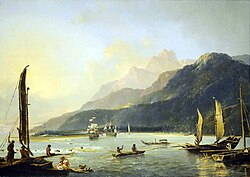Tahiti rail
The Tahiti rail (Gallirallus pacificus), also known as the Tahiti red-billed rail, or Pacific red-billed rail, is an extinct species of rail. It once lived on Tahiti. The second voyage of James Cook in 1773 got one. It was described by Johann Reinhold Forster and painted by his son, Georg. The Tahitian name was ebōnā or ōmnā.
| Tahiti rail | |
|---|---|

| |
| Many paintings of the bird. | |
| Conservation status | |
| Scientific classification | |
| Kingdom: | |
| Class: | |
| Order: | |
| Family: | |
| Genus: | |
| Binomial name | |
| Gallirallus pacificus | |
Name

Due to confusion about the name, the name Rallus ecaudatus was commonly used in the mid-late 20th century to refer to this bird. This is, however, in error, as the name is a subspecies of the buff-banded rail. Today it is known as Gallirallus philippensis ecaudatus. Also, at least once, the Tahitian bird has been referred to by the scientific name of the Samoan wood rail, Gallinula pacifica, in a major scientific work.
Extinction
Not much is known about the bird's extinction. One idea is that the bird might have been prey to other species. The bird's habitat had active volcanos.
Tahiti Rail Media
James Cook's ships off Tahiti during his second voyage when this rail was found, William Hodges, 1776
1907 illustration by John Gerrard Keulemans, based on Forster's plate; the legs are depicted too brightly red.
The Tongan subspecies of the buff-banded rail, which has been confused with the Tahiti rail
Sources
- BirdLife International (2004). Gallirallus pacificus. 2006 IUCN Red List of Threatened Species. IUCN 2006. Retrieved on 29 June 2006. Database entry of the bird includes justification for why this species is extinct.
- Gmelin, Johann Friedrich (1879): [Description of Gallirallus pacificus]. In: Systema Naturae (13th edition) 1, part 2: 717.



